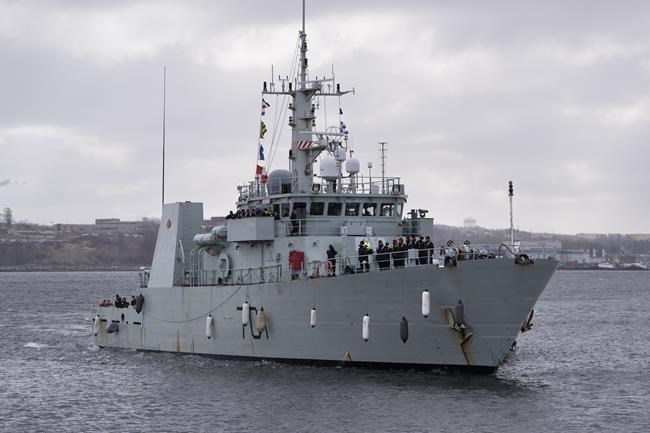OTTAWA — The Defence Department's procurement chief is hoping to have a better sense by the end of the year as to how much Canada will have to pay to build a new fleet of warships for the Royal Canadian Navy.
In an interview with The Canadian Press, assistant deputy minister of materiel Troy Crosby said officials continue to review and refine Ottawa's plan to build 15 new warships to replace the Navy's frigates and destroyers over the next two decades.
That includes moving closer to a final design and preparing to cut steel on a test model next year on what will eventually be the largest and most complex military procurement in Canadian history.
Yet Crosby said he won't have an updated cost estimate until at least later this year, when he expects Halifax-based Irving Shipbuilding to submit a formal plan for building the first three ships.
"We will have a better sense of that once we get through to the shipyard's proposal for the build of the first batch of three ships, which I would expect to receive later this year," he said.
Defence insiders and industry have been eagerly awaiting word on how much the government expects the ships to cost. A big increase is likely to force the government into making a tough decision: find more money or scale back on the fleet.
The government's most recent estimate in 2017 was around $60 billion, which was more than double the original budget of $26 billion earmarked for the fleet when Irving was selected to build the warships in 2011.
In a report last year, parliamentary budget officer Yves Giroux pegged the price at more than $84 billion — and climbing — as the project continues to hit delays. Officials have questioned that figure, but acknowledged the price will be higher than in 2017.
That has prompted questions about whether this government or a future iteration will scale back its plans and purchase fewer ships, which are based on a British design known as the Type 26 and slated to be built by Irving Shipbuilding in Halifax.
The new fleet of so-called Canadian surface combatants is supposed to replace the Navy's 12 Halifax-class frigates, which are currently serving as the navy's primary workhorse and increasingly showing their age.
The warships will also replace the Navy's three Iroquois-class destroyers, which were decommissioned six years ago, leaving Canada with a smaller naval fleet — and without any long-range air defence capabilities at sea.
While Ottawa and Irving work on a plan to build the new warships, the government recently submitted a letter to the U.S. asking for more information, including a price, on up to 16 P-8 Poseidon surveillance planes and associated equipment.
The request for information followed discussions with industry and allies about replacing for the Air Force's aging CP-140 Auroras, which the government said identified the Poseidon as the only aircraft able to meet Canada's requirements.
Crosby said the request does not commit Canada to buying the Poseidon, which is built by U.S. aerospace giant Boeing.
Rather, he said Ottawa wants a real answer from the U.S. government — rather than Boeing spin — on the Poseidon's costs and capabilities, as well as whether they could be delivered in time to replace the Auroras, which first entered service in the 1980s.
"That gives you the kind of information that isn't just sort of a business-development version," he said. "You have a good ally that's going to provide you that information to give you a solid decision space."
Crosby also pushed back on suggestions Canada is increasingly turning to sole-sourced deals when it comes to military procurements, as a result of growing frustration and concerns over the system's current pace.
While Defence Minister Anita Anand recently announced that Canada would fast-track the purchase of new weapons for Canadian troops to defend against Russian tanks, aircraft and drones in Latvia, Crosby said competitions are planned.
This report by The Canadian Press was first published April 21, 2023.
Lee Berthiaume, The Canadian Press



